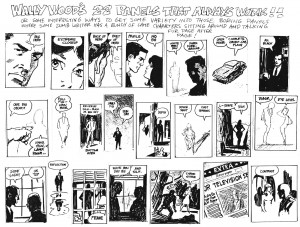So you’ve visited your local comic book shop and actually talked to a “Comic Book Guy.” You’ve started to buy comics, trade paper backs, for your classroom. Now you’re trying to figure out how to integrate comics into your classroom. It’s easier than you think. You probably have been asked to have Reader’s and Writer’s Notebooks so add a drawing sketchbook to that and you’re ready to begin.
First of all don’t over think it… like so many things in education we spend a lot of time trying to get round pegs to fit into square holes. To start most kids (unless they’ve been squashed) like to draw, or doodle. If they say they can’t start with simple drawing lessons. For years I’ve used Mark Kistler’s Draw Squad which has 180 lessons. Is it a coincidence that we have 180 days in a school year? Probably. I have used these lessons with every grade I have taught and amazingly enough they tend to be one of the things my students remember the most about my class. One year I was asked to cover for the technology teacher… that class actually took over the daily lesson (thank you Elaine) they were third graders. To me this is an addition to handwriting (which we don’t teach anymore). Start accepting student illustrations of things. A scene from a book, a science experiment… have them tell a story with their pictures. When you meet with them, ask them to write down what is happening in the pictures, a caption if you like. I had a special ed student one year who if I asked him to write I’d get nothing, if I asked him to draw, the page was amazing, then I could ask him to add text and I ended up with finished pieces that would rival my gifted kids.
So get your class is drawing every day. After a week or so of this talk to them now about the basic parts of a comic, the language of comics:
Gutter – the space between panels
Panel – a picture representing a moment in time
Speech Bubble – what a person says
Thought Bubble – what a person thinks
Special Effects – SHRAAKOOOOOOM!
Have them take their drawings to the next level using comic construction to tell about things they do in the classroom. A math problem? A class rule?
In the beginning these should be fairly simple. so as not to stop the fun of creating a comic. Remind your class that simple scenes might not need much planning but as they get more complex you need to work a little harder.
Project #1- A Scene from a Book/Story
Have your students take a story they are reading and adapt it to a comic. I would have them find a scene that has either action or dialogue. The first chapter introducing the characters and plot, are a little more difficult. This should start off with just stick figures. Keep it simple, they can always make it more complex later on.
Once the student has chosen the scene, make a copy of that so you can conference and make sure it includes everything. You can look for storyboards from films to use as examples, since they are basically comics, although they may frustrate some kids thinking that they must produce something like that, which they may not have the drawing skill. You know your students.
Teacher Tip: This will take more time that you think so be flexible. Some students will love it, others will need a little convincing, but give them time… I wish I could tell you how long, but each class is different.
Once they have a quick draft plotting out the beats of the scene, then talk to them about details. The setting and the characters will need some kind of detail so you can tell them apart. Does it happen inside or outside? Kids talking to adults? A boy talking to a girl? Two girls talking? What makes them look different? Did the author give you enough detail or leave it to you?
This keeps you away from having the kids write a script (next week) until they have an idea as to how a comic is constructed. They use the author’s script from a book they are reading.
This is a fairly easy project to grade on the comic end (you can always grade on spelling & grammar). Take that copy of the scene and walk through it with the student. If it is a faithful adaptation, smile and give it a good grade. Remember the idea will always be to communicate. If the student succeeded in doing that, then they deserve a good grade. For advanced students you can always shoe them Wally Wood’s 22 panels that always work as a way to vary dialogue panels.

So, there’s a start a simple scene, which could be taken into a moment in history, a science experiment… give your class illustration as a option when it comes to written projects. If they can tell you what happened with pictures then you can move into having them describing things is words.

